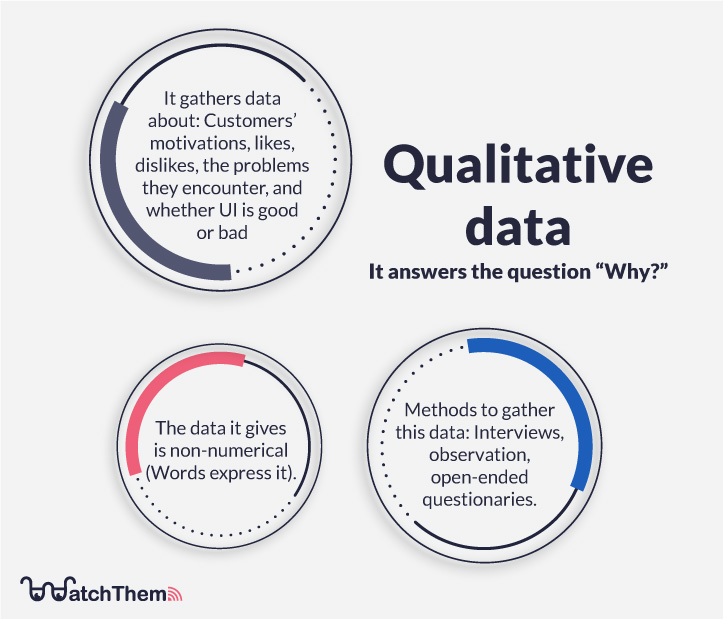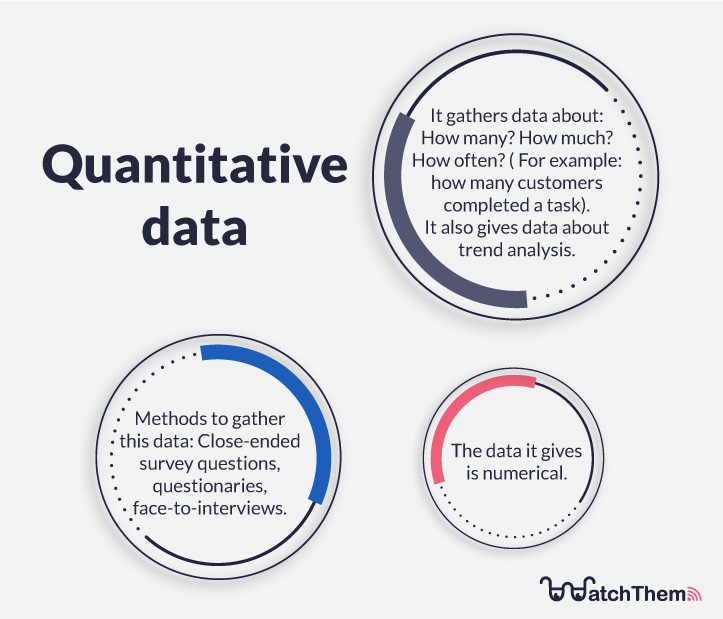Page Contents
When you start a business, you should pay attention to different variables. One of them is the user experience which we also know by UX. Your UX design can make or break your business. So it’s important to take some measurements. That’s why quantitative vs. qualitative testing is a delicate subject!
Quantitative and qualitative testing work together but are very different concepts. Simply, quantitative testing presents you with numerical values, and qualitative testing determines your users’ motivations, comments, feelings., etc. throughout the test process. That’s the kind of data CRO tools offer!
Platforms such as WatchThemLive allow you to gain deep insight into your target audience and their interaction with your website and services. With its features, you can collect both qualitative and quantitative data. You can sign up here to get right into the business!
But there is so much more to these testing methods! If you want to know more, keep reading because this article is about qualitative vs quantitative research and everything you need to know about them.
What Is Qualitative Testing
Tests have always been a nightmare ever since school with all those quizzes and exams. But now, you’ll be the one running the tests! Qualitative testing is a type of research that helps you understand user behavior and the elements affecting it by observation.


In order to give your customer the best experience, you need to know what their motivations and reasons are when they take a certain action. This helps you understand what users like and dislike about you, why they buy or don’t buy your product, and whether your UI is good or not. It basically gives you accurate, detailed, and non-numerical data.
Qualitative Testing Methods
Now, you might be thinking: ‘How can I run qualitative tests?’ There are different ways to do this. We introduce some of them here:
- Interviews,
- Open-ended questionaries,
- Quizzes,
- Focus groups,
- Direct observation .
In this case, having a session replay tool is essential for you as it can easily do qualitative tests on your behalf. Session replays record users’ screens from the moment they enter your site. You can see what is stopping them from going through your sales funnel or what makes them frustrated enough to leave your site. It also shows how many people visit a certain page on your website and your bounce rate.
We’re more than happy to announce that our customers are highly satisfied with the session replays we offer. Not only does WatchThemLive’s session replay allow you to record users’ screens on your website and run qualitative and quantitative testing, but also it enables you to apply active filters to save time and energy.
Sign up on WatchThemLive for a better conversion rate! Are you ready?
Examples of Qualitative Testing
Imagine you’re running a cotton candy cart and you have a customer. You ask them ‘why did you buy the cotton candy?’ They may answer: ‘the coloring attracted me, and I wanted to have some.’ This way, you’re running a face-to-face interview to get insightful information. Now that you know colors can attract more customers, you’re ready to add more colorful cotton candies!
Or, if you have an online shop, you can run an open-ended survey( it has to be open-ended because you’re not looking for numbers; you want to know people’s thoughts). You can ask your visitors how their check-out process was. They might answer: ‘It was an easy process, but the payment methods were limited.’
This way, you’re gathering information about what people think about you and your business. This opens ways for more improvement and a better customer journey.
What Are the Different Types of Qualitative Testing
You might think that there is only one type of qualitative data, but there are actually different types. They all use the same data collection methods, as we said before, but the purpose of the testing makes them different. Let’s review three of the main types together:
Narrative: The narrative method involves interviewing a small group of people about the topic you want to get information about. It focuses on the story from the customer’s point of view, but that’s not all that there is to it. Researchers combine the data they gathered with the information they got from reading documents to get the best result. Since you’re receiving in-depth information about customers, the narrative method can help you create a persona.
WatchThemLive allows you to gain deep insight into your customers’ opinions and thoughts regarding your business by offering video testimonials. Using this feature, you can ask your users to share their experience with your products and services through videos. Then you can go over these recordings to gather the necessary information or, share the videos on any platform to promote your business in the best possible way and gain exceptional credibility and trust!
- Case studies: This method investigates problems in a specific environment, situation, company, or organization. There are different types of case studies, such as explanatory, exploratory, and descriptive. Researchers can use this method in quantitative testing as well.
- Ethnographic: In this method, researchers watch the customer use a product in their own environment. Market researchers usually use this method to understand how customers interact with their product, gaining insight into customers’ likes and pain points revolving around products or services. Sometimes, researchers follow customers to their houses or offices to see how they work with the product.
What Are the Advantages and Disadvantages of Qualitative Testing
If you’re considering using qualitative testing for your business, first yu should know what advantages and disadvantages of this method are. So here’s your guide!
Qualitative Testing Advantages
- Helps you discover the ‘why’ behind customers’ actions,
- Explains things that numbers alone can’t reveal,
- Unlike quantitative research, qualitative testing is not bound by limitations,
- It’s more flexible,
- Allows a personal connection with the customers,
- It can be more concentrated.
Qualitative Testing Disadvantages
- Small sample size,
- The results alone might not reflect the whole truth,
- You only get answers t your asked questions so researches should choose the questions carefully,
- Can be hard to find volunteers to participate in your surveys or interviews.
What Is Quantitative Testing
A quantitative test is all about numerical data. For example, it tells you how many customers completed a task, how hard it was for them to contact you on a scale from 0-10, or how often they buy clothing.


What we said just now are some examples to show you that quantitative testing is all about numbers no matter what you want to know. Quantitative testing compares the usability of your product to a previous version or any other metrics that you want. It’s also used for benchmarking since you can compare any metrics that can be calculated, such as sales or conversion rates. It doesn’t give you reasons or solutions—numbers only.
A good thing about quantitative testing is that it involves trend analysis. Trend analysis shows you the way to spot the changing pattern of trends. Customers’ behavior and needs are shifting rapidly, so you need trend analysis to change your products and services to respond to your customers’ needs.
Quantitative Testing Methods
Now, let’s see how you can gather quantitative data. There are different methods; Here are some of them:
- Close-ended survey questions,
- Longitudinal studies: this means testing the same subject over an extended period of time (you may want to repeat it for years.) It’s usually used for trend analysis,
- Surveys such as questionnaires ,
- Polls,
- Face-to-face interviews.
Data gathering plays a vital role in your business success. You can’t collect it manually, so you need a tool. WatchThemLive is an analytics platform that gives you accurate data about users’ languages, countries, traffic sources, page views, bounce rate, and so much more.
Imagine you want to gather quantitative data about your customers. With WatchThemLive’s web analytics you can see what percentage of your visitors use a specific operating system so you can design your website in a way that adapts to that system.
Eager to boost your revenue? Waste no time and sign up now!
Examples of Quantitative Testing
You can run a survey and ask your users if they will attend the opening of your new branch. Here you’re giving them options to choose from since you need numbers and want to know how many users will come. The options might be yes, no, or I haven’t decided yet.
You can use longitudinal studies before launching a product when it’s in the beta testing stage. You can ask 100 users how much they like the new updates of your products on a scale from 0-10. Based on the number of content people, you can decide whether to finalize your update or not.
What Are the Different Types of Quantitative Testing
If you want to try your hand at quantitative testing, first you need to know its different types and methods! Here we’ll explain four of the main types of quantitative testing:
- Experimental research: This method tries to prove a hypothesis by experimentation. Researchers choose one or more independent variables, manipulate them, and then assign them to dependent variables using scientific methods. For example, let’s say the independent variable is the price and you want to see its effect on the dependent variable which is sales. Researchers can easily change the price of a product and experiment whether there will be changes in the number of sales or not.
- Quasi-experimental research: In this method, two variables, dependent and independent, are examined to identify the cause-effect relationship between them. Researchers use this type of testing to understand the cause of the issue. However, quasi-experimental research is not truly experimental since you don’t choose the participants’ groups randomly. To run this test correctly, you should use a variable without any changes. Then you can see the effect of the independent variable on the dependent variable. Researchers use this type when it’s impossible to run a true experiment.
- Correlation: In this type, the researcher examines the relationship between dependent and independent variables without manipulating any of them. It shows the direction of the relationship between two or more variables. The direction can be either positive or negative.
Descriptive: In the descriptive type, researchers use case studies, observation, and surveys to collect data about changing subjects. They use this method to find the answers to an experiment’s what, when, where, and how.
What Are the Advantages and Disadvantages of Qualitative Testing
Now it’s time you learned whether this testing method is the right choice for you by going over its pros and cons!
Quantitative Testing Advantages
- It’s verified by facts and reliable resources,
- It can be done anonymously and doesn’t require participants to share their identity,
- Researches don’t need to keep track of every little step in quantitative testing,
- The sample size is often bigger compared to qualitative testing,
- You can use the results right away without further analysis,
- You can collect data using this testing method quickly,
- You can duplicate the results as the general conclusion is always accurate.
Quantitative Testing Disadvantages
- You might lose important information as it only focuses on numeric data,
- Quantitative research model is hard to create,
- It can be expensive,
- Doesn’t answer the ‘why’ behind customers’ actions,
- Sometimes answers by individuals can’t represent the whole population.
What Is the Difference Between Qualitative and Quantitative Testing
Before choosing one of these research methods, you need to know their differences. To understand the exact differences between qualitative and quantitative testing, look at the table below:
| Qualitative Testing | Quantitative testing |
| The answers it gives you: Why | The answers it gives you: How many and how much |
| You can use it to test or confirm a hypothesis | You can use it to understand users’ thoughts or experiences |
| Words express it | Numbers, graphs and tables express it |
| You can get results even with a few participants | You need lots of participants for accurate results |
| Open-ended questions | Close-ended questions with multiple options |
When to Use Qualitative and Quantitative Testing
In a nutshell, use a qualitative test when you need to understand customers’ thoughts, emotions, motivations, and get an overall understanding. When you want to test something or measure a hypothesis, use a quantitative test, such as finding out how many people abandoned their shopping cart.
Qualitative testing is best for detecting the main problem in your design. For example, you can run a qualitative test to realize what is stopping customers from signing up on your website, and based on that, you can conclude that your sign-up form has too many parts. Customers might drop after inserting their username, password, and email. They wouldn’t stay to enter their phone number and wait for the verification code as well, for example.
Quantitative testing measures the usability of your website with numerical data. The website design is complete, and you want to know the users’ experience while interacting with your site. It can show you the number of completed tasks and task duration. It also lets you compare an older version of your product or website with the new one, Basically, it shows you what’s working and what’s not with numerical data.
However, this testing method needs a large group of participants to get reliable insights, which can be pretty expensive. Unlike qualitative testing, it can’t directly affect the redesign of your website. Still, the numbers you gain from this method can help you understand whether your website needs a redesign or not.
Why Qualitative and Quantitative Testing Is Important
Now that you know everything about quantitative vs. qualitative testing, it’s time you learned why it’s important to use them in your business. Whether you are happy with your customer flow or you want to improve it, you should never underestimate the power of testing! It will allow you to gain deep insight into your customers’ behavior in addition to revealing areas for improvement.
By running qualitative and quantitative tests, you can send a more personalized message to your customers, provide a smooth UX, fix any possible pain points and inquiries, and optimize your website in a way that boosts your conversion rate.
Quantitative vs. Qualitative Testing: Which One Is Better for Data Analysis
Even though qualitative testing provides great information about the reason behind every customers’ actions, it’s not the best option for data analysis. On the other hand, quantitative testing is a great method for gathering accurate and reliable numeric data.
The results of this research method is based on facts and numbers and can hardly be underestimated. They are more concrete and can be organized and searchable. That’s why it’s a better option for data analysis.
But a smart business owner knows that relying on the results of just one research method is not really helpful. That’s why it’s always recommended to use both quantitative and qualitative testing together to reach your business’s fullest potential. The numeric data provided by quantitative testing combined with valuable data on your users’ behavior and journey provided by qualitative data will guarantee a great boost in your conversion!
FAQs on Quantitative vs. Qualitative Testing
Now let’s go over some frequently asked questions regarding qualitative and quantitative testing.
Q1. How Do Quantitative Tests Differ from Qualitative Ones?
Qualitative tests find the answer to the ‘why’ behind your visitors’ actions and purchases and is descriptive in nature. On the other hand, quantitative tests provide data on numeric variables such as the number of your website visitors, retention rate, etc.
Q2. Is Quantitative Testing Better than Qualitative?
To put it simply, no. We can’t say one of them is better than the other one. Each testing method has its own value and worth when it comes to optimizing your business and testing your variables. You need to pay attention to the nature of your business and see which one is more useful.
Final Verdict on Quantitative Vs. Qualitative Testing
Giving your customers the best customer journey might be the most critical part of your job. There are many ways to improve your customer journey. One of them is qualitative and quantitative testing. Qualitative data provides you with non-numerical data to understand people’s emotions and thoughts and quantitative data gives you numerical data about users who interact with your product or website.
In this article, we explained what qualitative and quantitative testing are, the qualitative vs. quantitative data-gathering methods, and examples of them. Moreover, we presented their differences, when you should use each of them, and their different types.
One of the best methods for gathering qualitative and quantitative data is using a web analytics tool like WatchThemLive. With its session replays, heatmaps, web analytics, and user tracking, you no longer have to think about ways to collect data.
Sign up for FREE and see what’s waiting for you!

